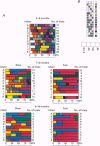Abstract
1. The aim of the study was to find out whether the development of postural adjustments occurs via a coupling of simple muscle responses, such as stretch reflexes, or via selection from an innate repertoire of centrally generated response patterns. 2. Postural responses during sitting on a moveable platform were assessed in eleven healthy infants at 5-6, 7-8 and 9-10 months of age. Multiple surface EMGs and kinematics were recorded while the infants were exposed to slow and fast horizontal forward (Fw) and backward (Bw) displacements of the platform. 3. From the youngest testing age onwards, largely variable but direction-specific muscle activation patterns were present. Fw translations resulted predominantly in an activation of the neck flexor, the rectus abdominis and rectus femoris muscle, while the neck-, thoracal- and lumbar extensor muscles (NE, TE, LE) and the hamstrings (Ham) showed varying amounts of inhibition. During Bw translations NE, TE, LE and Ham were preferably activated. The muscle activity could not be explained by simple stretch reflex mechanisms, but is likely to reflect centrally generated motor activity maturing in a predetermined way. However, indications for a contribution of stretch reflex mechanisms were also present. 4. With increasing age the variation in muscle activation patterns decreased, resulting in a selection of the most complete patterns. The ability to modulate the amplitude of the selected, most complete patterns during Fw translations, with respect to platform velocity and initial pelvis position, emerged at 9-10 months.
Full text
PDF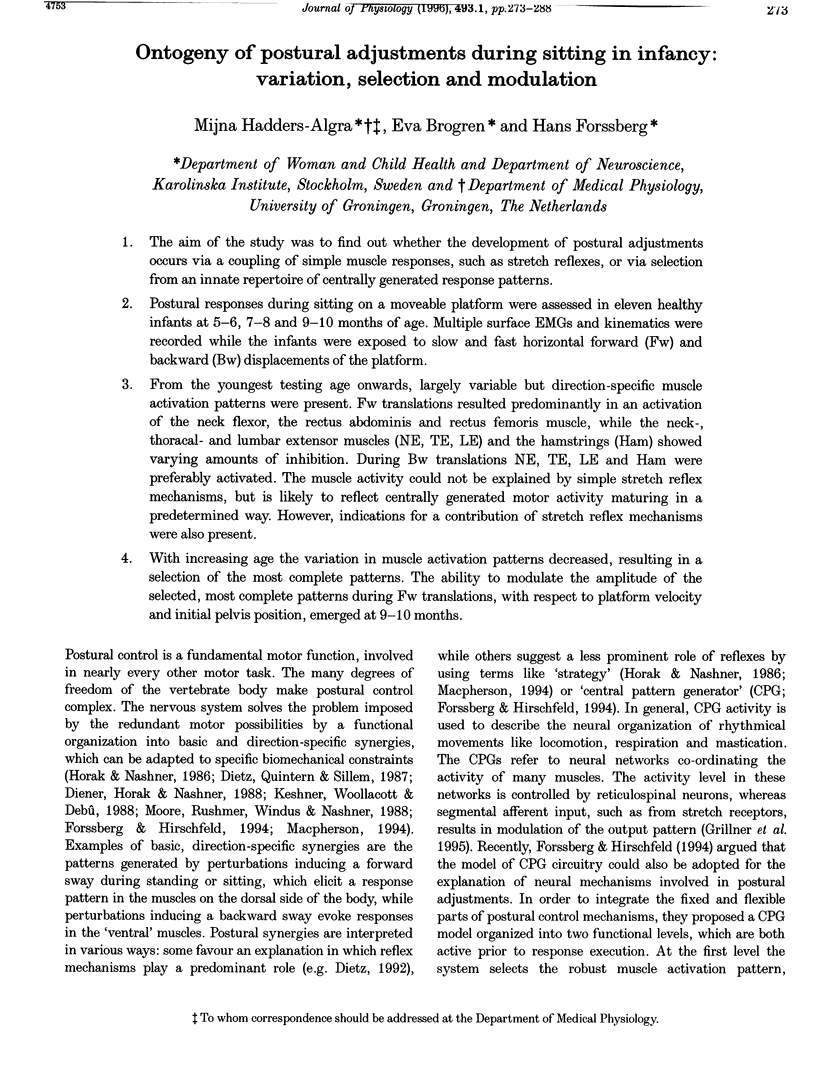
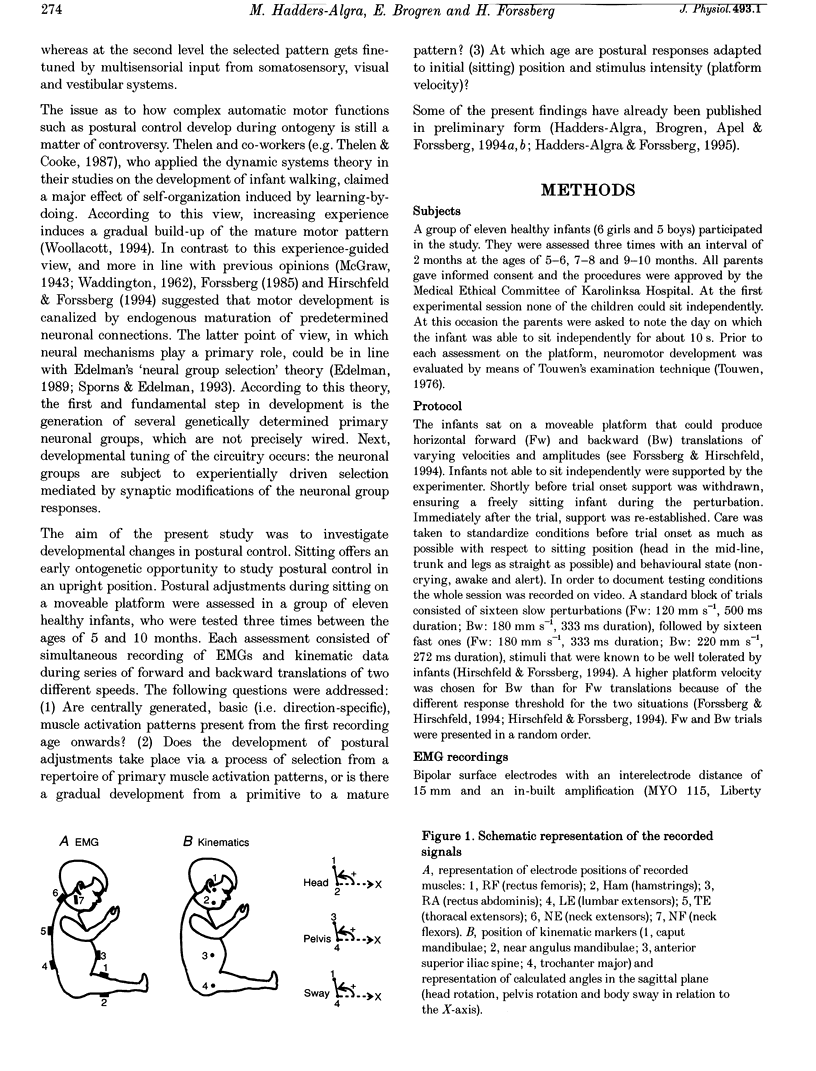
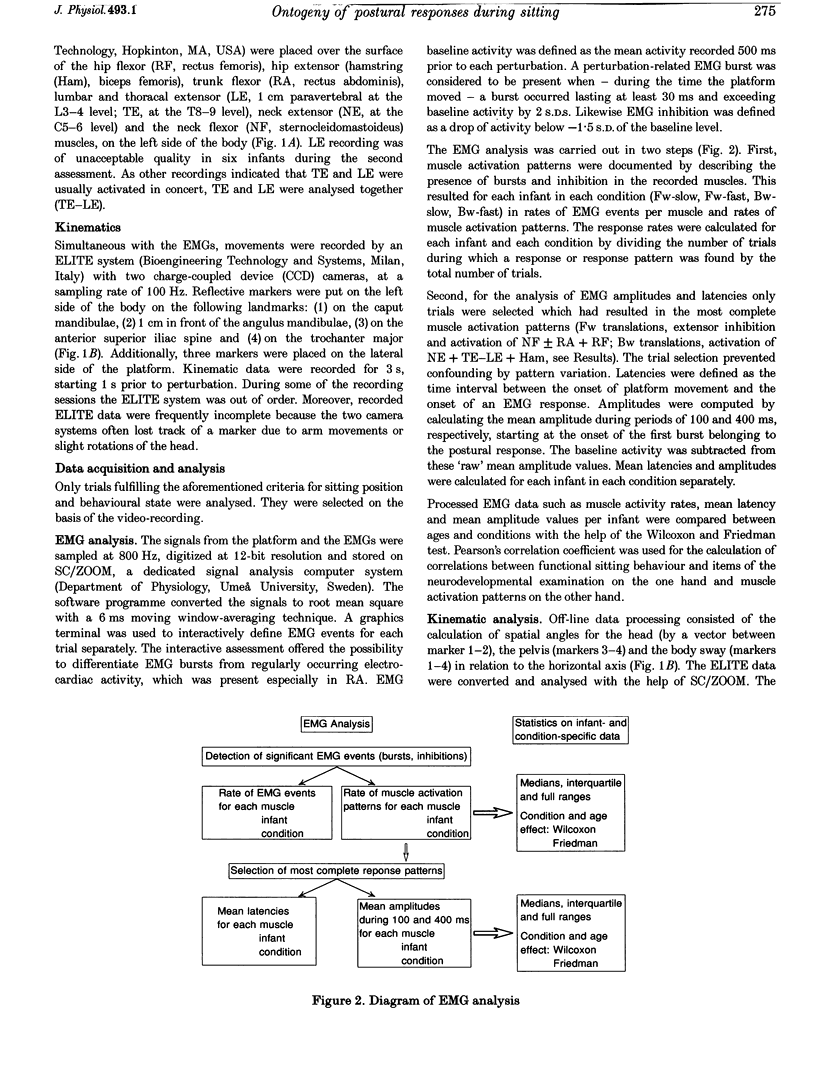
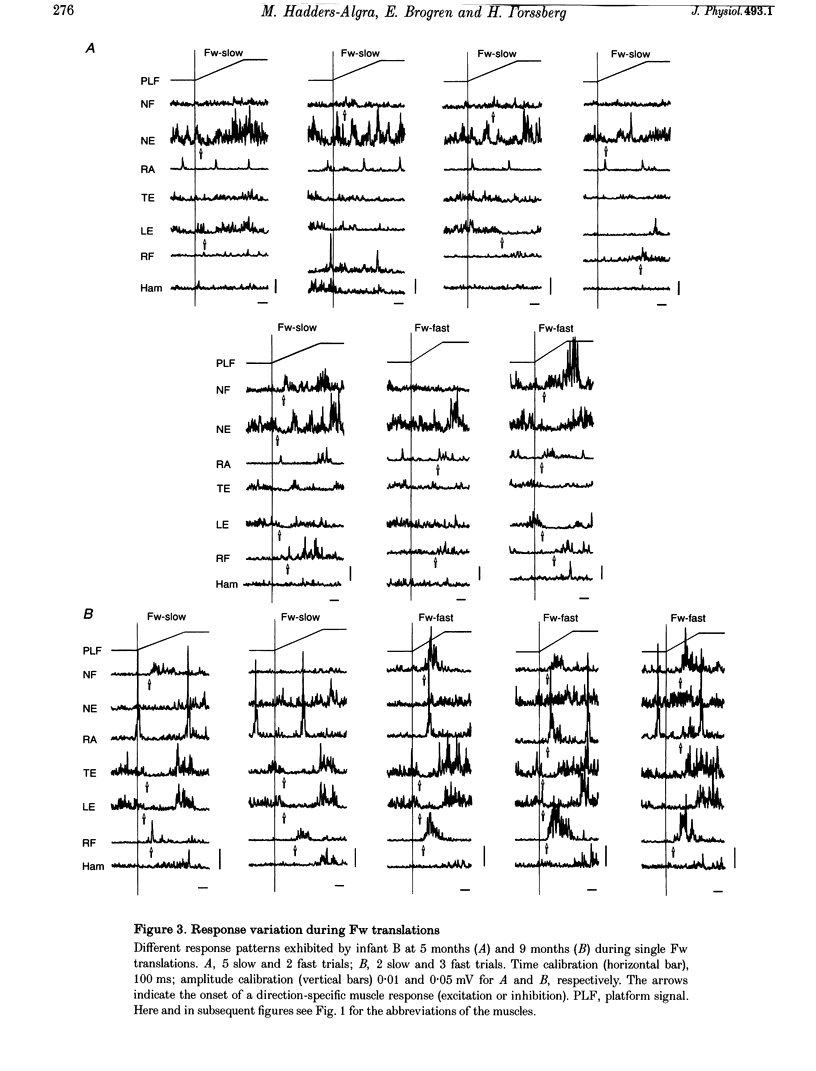
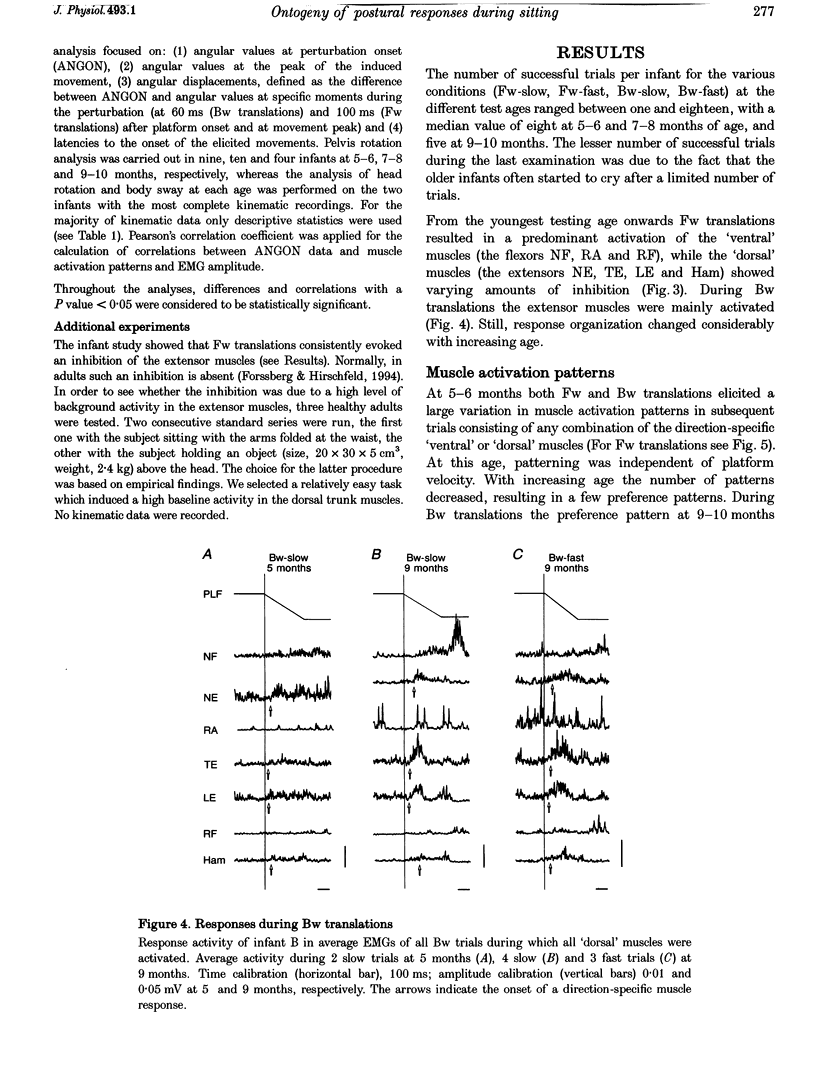
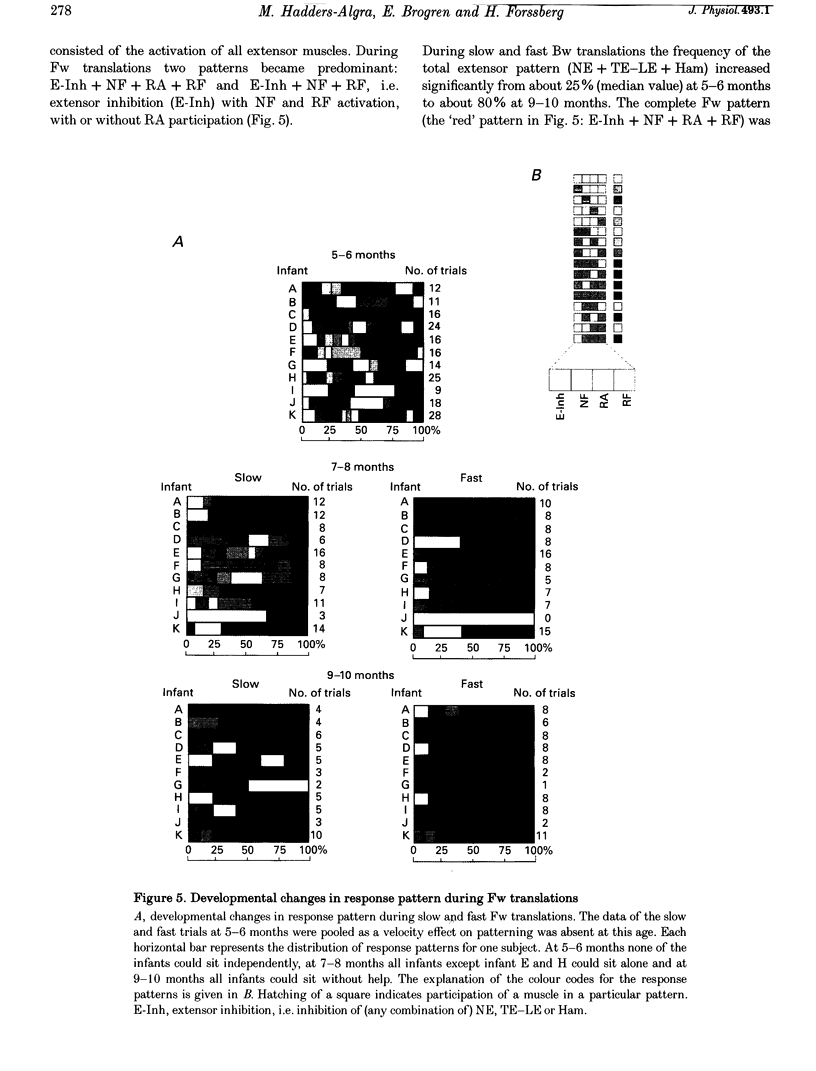
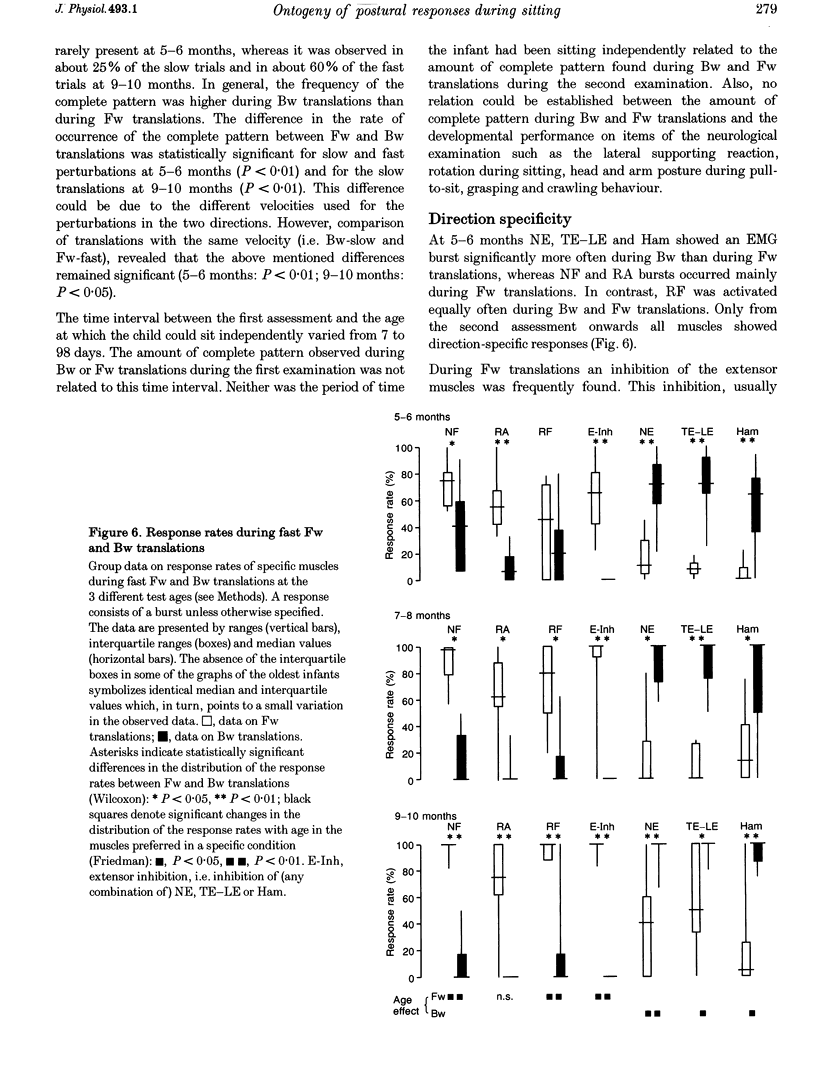
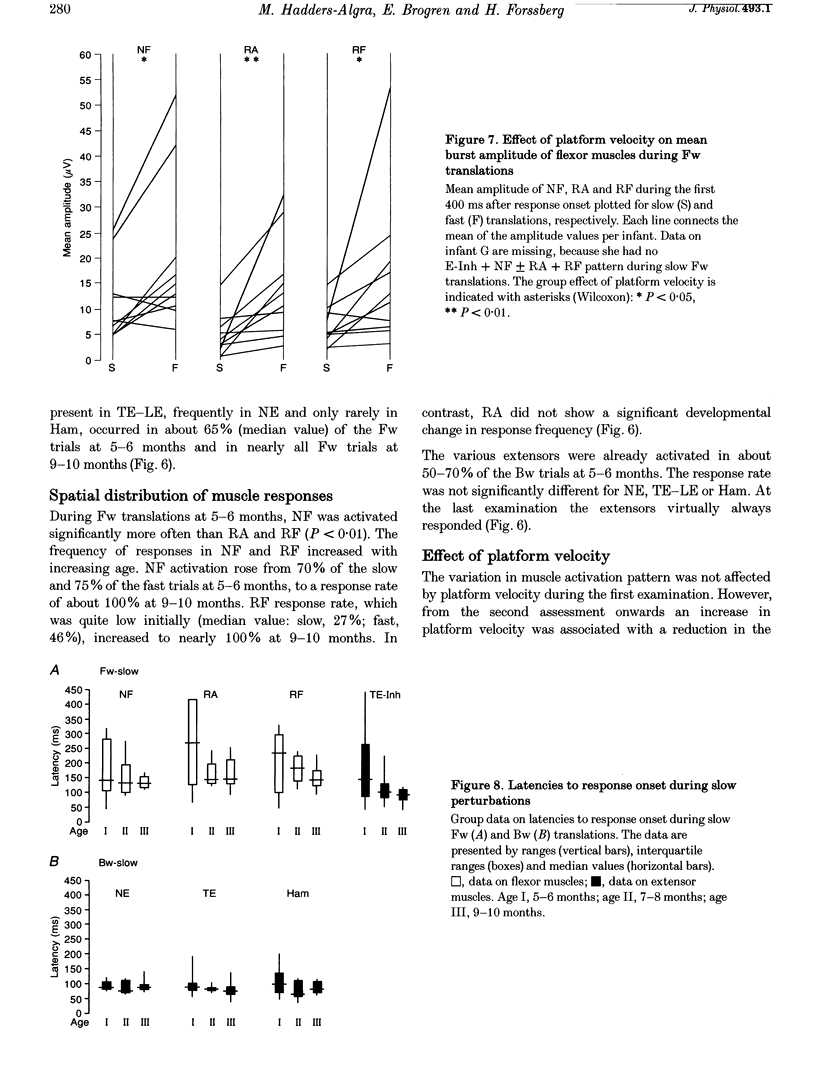
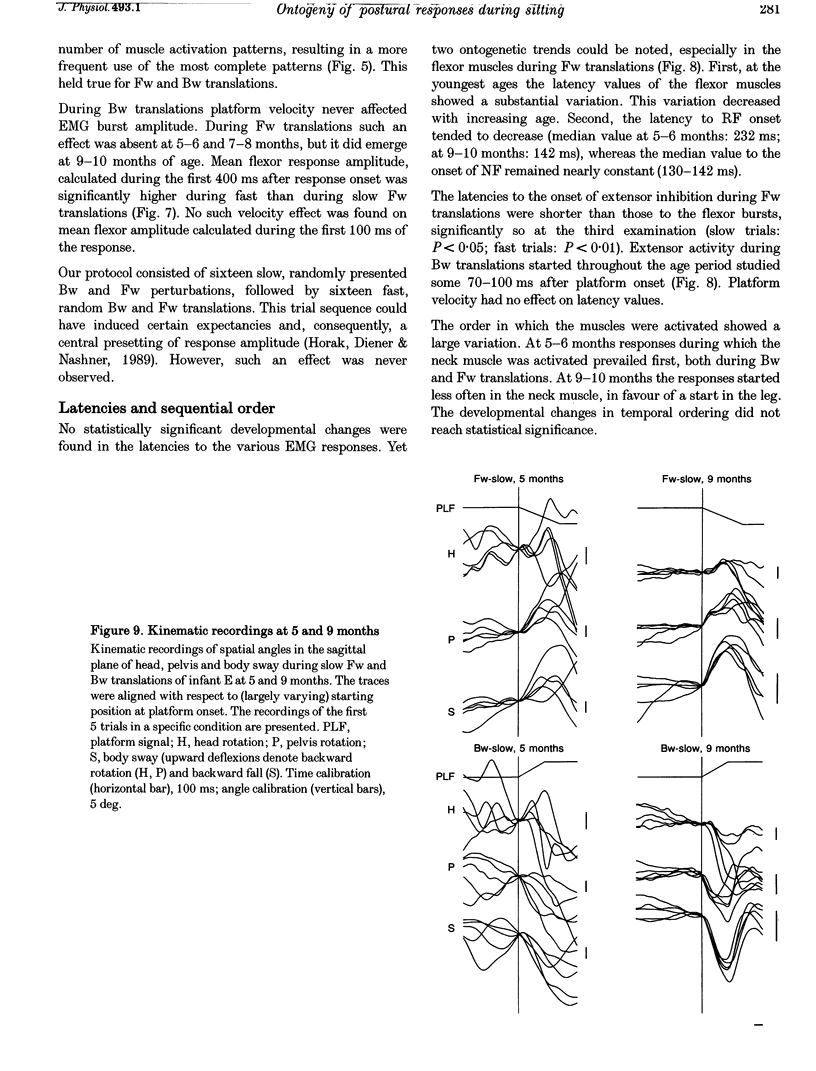
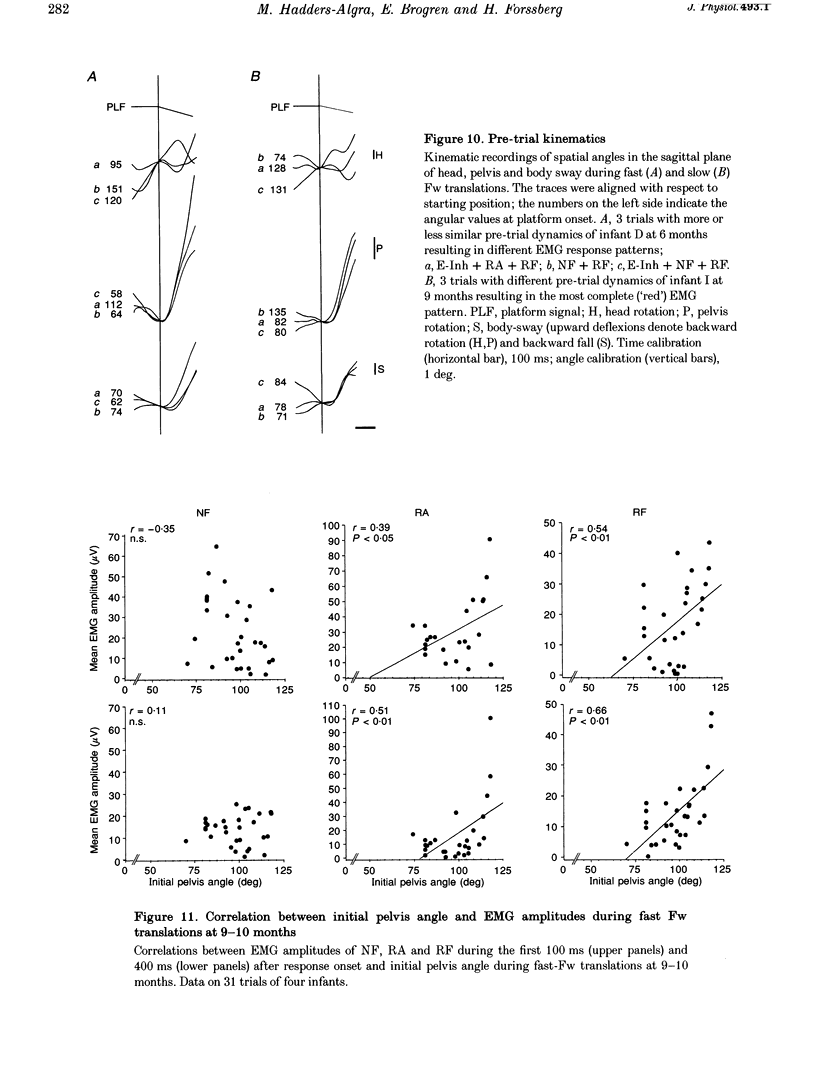
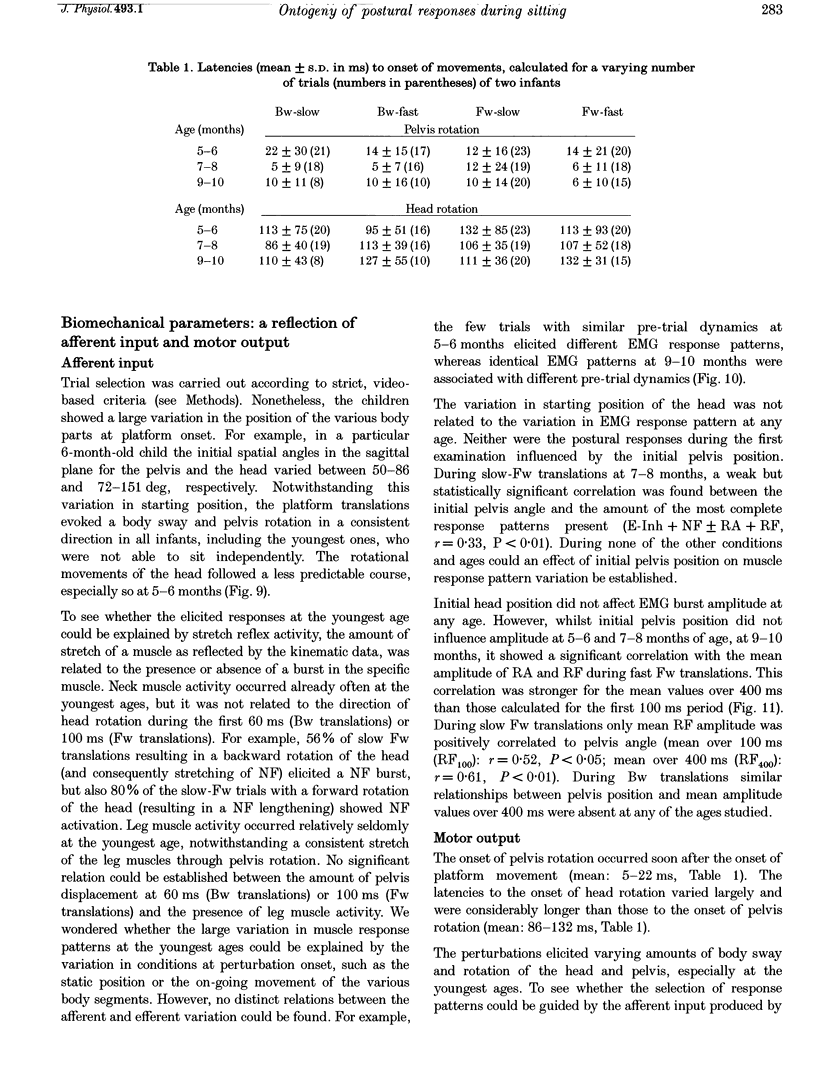
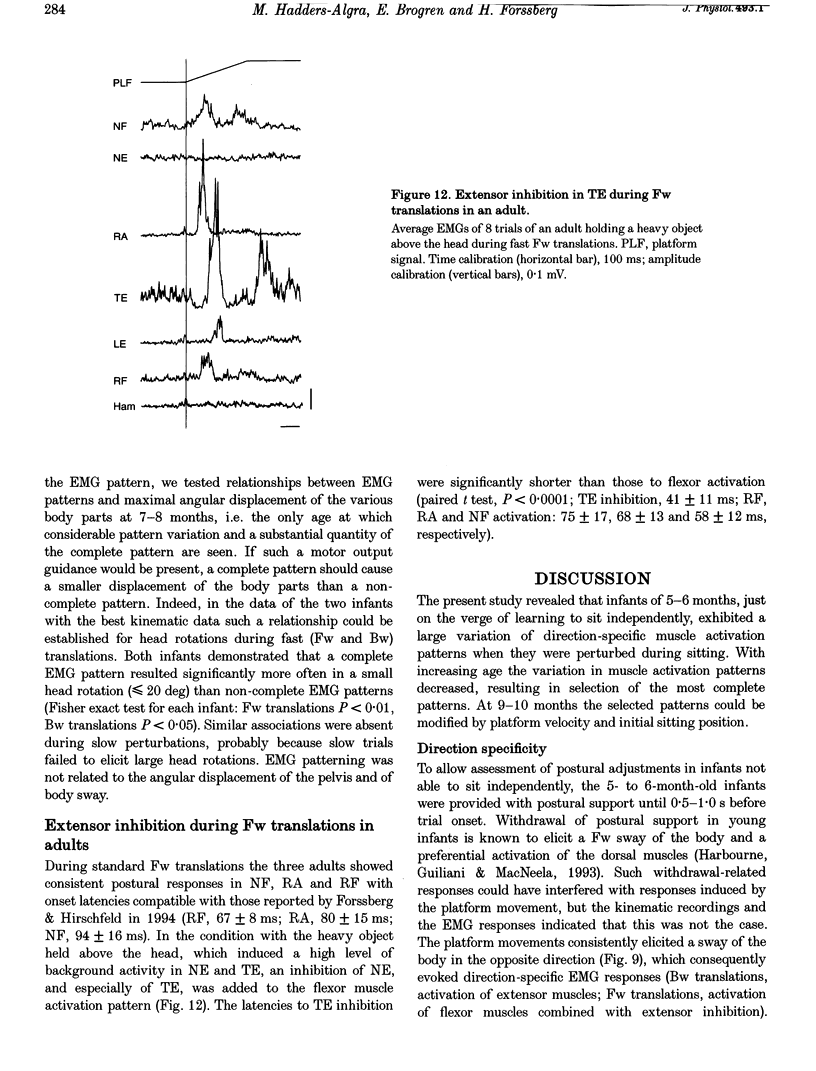
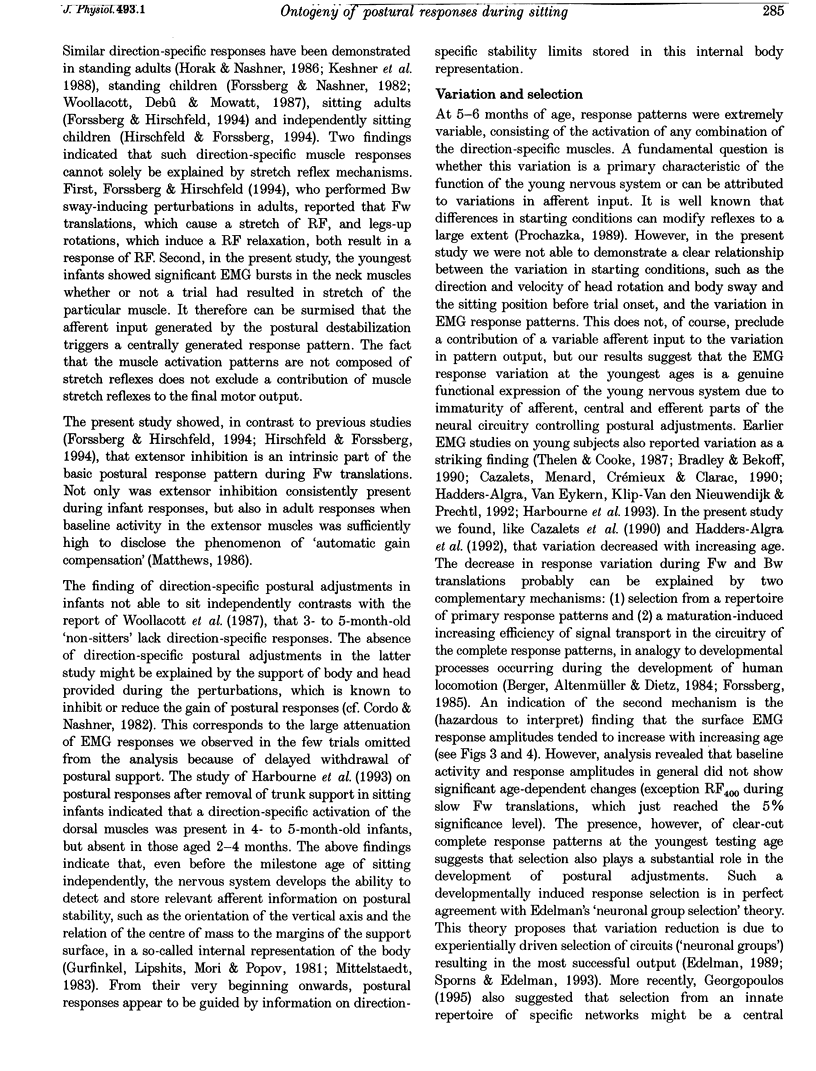
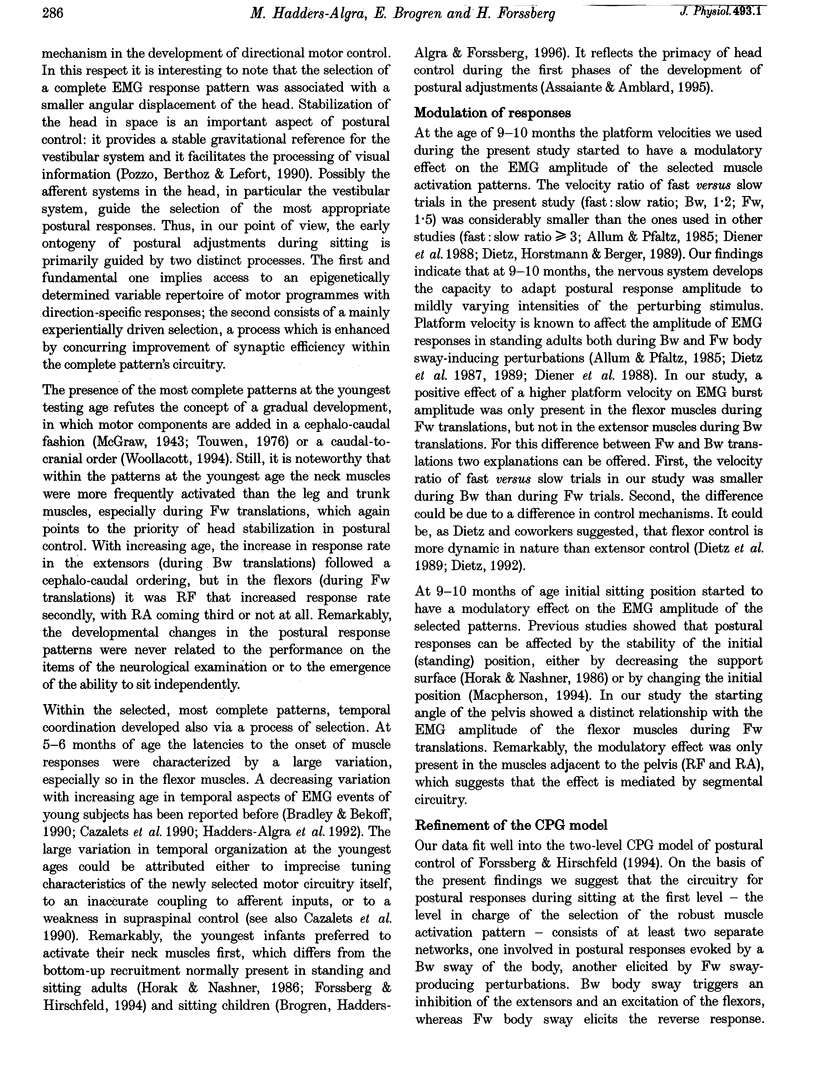
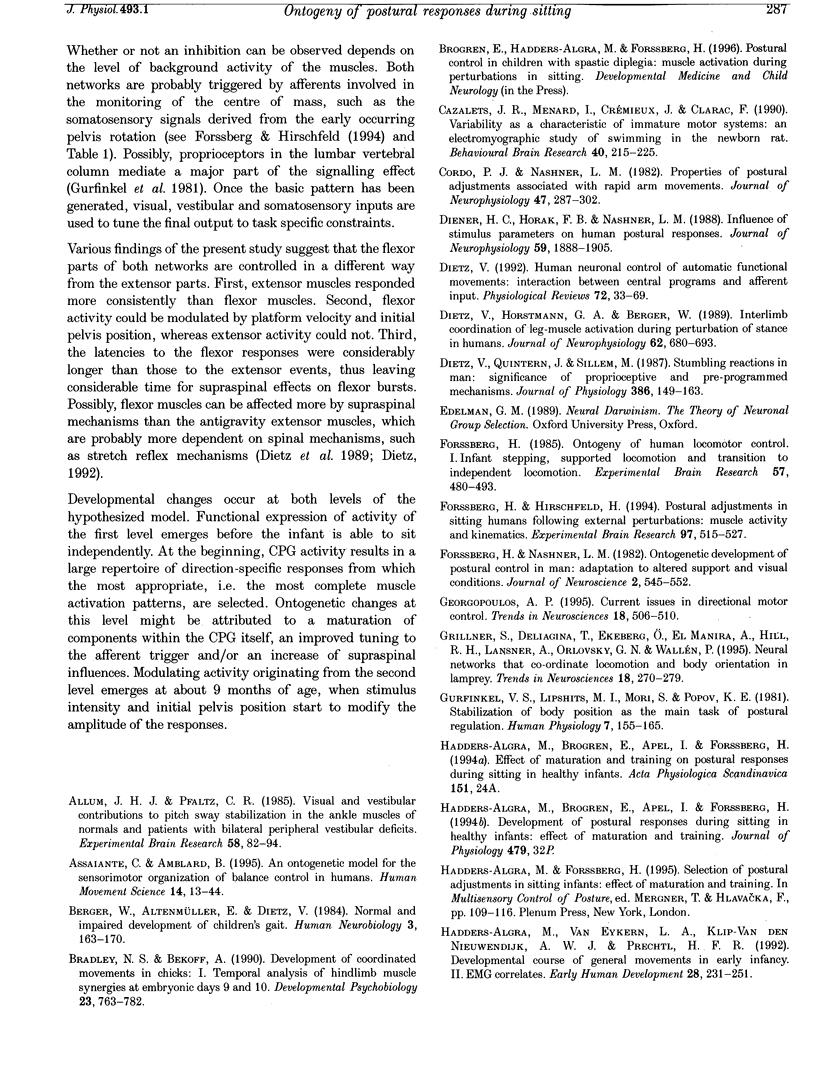
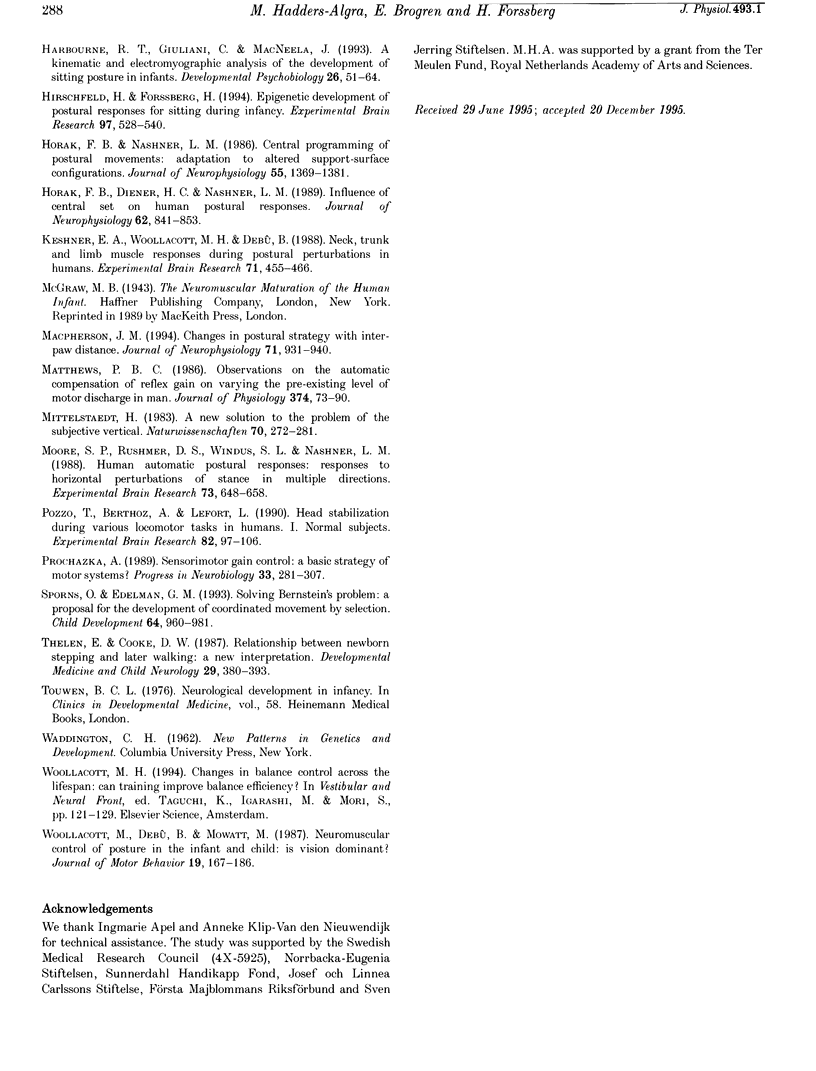
Images in this article
Selected References
These references are in PubMed. This may not be the complete list of references from this article.
- Allum J. H., Pfaltz C. R. Visual and vestibular contributions to pitch sway stabilization in the ankle muscles of normals and patients with bilateral peripheral vestibular deficits. Exp Brain Res. 1985;58(1):82–94. doi: 10.1007/BF00238956. [DOI] [PubMed] [Google Scholar]
- Berger W., Altenmueller E., Dietz V. Normal and impaired development of children's gait. Hum Neurobiol. 1984;3(3):163–170. [PubMed] [Google Scholar]
- Bradley N. S., Bekoff A. Development of coordinated movement in chicks: I. Temporal analysis of hindlimb muscle synergies at embryonic days 9 and 10. Dev Psychobiol. 1990 Dec;23(8):763–782. doi: 10.1002/dev.420230802. [DOI] [PubMed] [Google Scholar]
- Cazalets J. R., Menard I., Crémieux J., Clarac F. Variability as a characteristic of immature motor systems: an electromyographic study of swimming in the newborn rat. Behav Brain Res. 1990 Nov 30;40(3):215–225. doi: 10.1016/0166-4328(90)90078-s. [DOI] [PubMed] [Google Scholar]
- Cordo P. J., Nashner L. M. Properties of postural adjustments associated with rapid arm movements. J Neurophysiol. 1982 Feb;47(2):287–302. doi: 10.1152/jn.1982.47.2.287. [DOI] [PubMed] [Google Scholar]
- Diener H. C., Horak F. B., Nashner L. M. Influence of stimulus parameters on human postural responses. J Neurophysiol. 1988 Jun;59(6):1888–1905. doi: 10.1152/jn.1988.59.6.1888. [DOI] [PubMed] [Google Scholar]
- Dietz V., Horstmann G. A., Berger W. Interlimb coordination of leg-muscle activation during perturbation of stance in humans. J Neurophysiol. 1989 Sep;62(3):680–693. doi: 10.1152/jn.1989.62.3.680. [DOI] [PubMed] [Google Scholar]
- Dietz V. Human neuronal control of automatic functional movements: interaction between central programs and afferent input. Physiol Rev. 1992 Jan;72(1):33–69. doi: 10.1152/physrev.1992.72.1.33. [DOI] [PubMed] [Google Scholar]
- Dietz V., Quintern J., Sillem M. Stumbling reactions in man: significance of proprioceptive and pre-programmed mechanisms. J Physiol. 1987 May;386:149–163. doi: 10.1113/jphysiol.1987.sp016527. [DOI] [PMC free article] [PubMed] [Google Scholar]
- Forssberg H., Hirschfeld H. Postural adjustments in sitting humans following external perturbations: muscle activity and kinematics. Exp Brain Res. 1994;97(3):515–527. doi: 10.1007/BF00241545. [DOI] [PubMed] [Google Scholar]
- Forssberg H., Nashner L. M. Ontogenetic development of postural control in man: adaptation to altered support and visual conditions during stance. J Neurosci. 1982 May;2(5):545–552. doi: 10.1523/JNEUROSCI.02-05-00545.1982. [DOI] [PMC free article] [PubMed] [Google Scholar]
- Forssberg H. Ontogeny of human locomotor control. I. Infant stepping, supported locomotion and transition to independent locomotion. Exp Brain Res. 1985;57(3):480–493. doi: 10.1007/BF00237835. [DOI] [PubMed] [Google Scholar]
- Georgopoulos A. P. Current issues in directional motor control. Trends Neurosci. 1995 Nov;18(11):506–510. doi: 10.1016/0166-2236(95)92775-l. [DOI] [PubMed] [Google Scholar]
- Grillner S., Deliagina T., Ekeberg O, el Manira A., Hill R. H., Lansner A., Orlovsky G. N., Wallén P. Neural networks that co-ordinate locomotion and body orientation in lamprey. Trends Neurosci. 1995 Jun;18(6):270–279. [PubMed] [Google Scholar]
- Gurfinkel' V. S., Lipshits M. I., Mori S., Popov K. E. Stabilization of body position as the main task of postural regulation. Hum Physiol. 1981 May-Jun;7(3):155–165. [PubMed] [Google Scholar]
- Hadders-Algra M., Van Eykern L. A., Klip-Van den Nieuwendijk A. W., Prechtl H. F. Developmental course of general movements in early infancy. II. EMG correlates. Early Hum Dev. 1992 Mar-Apr;28(3):231–251. doi: 10.1016/0378-3782(92)90170-l. [DOI] [PubMed] [Google Scholar]
- Harbourne R. T., Giuliani C., Neela J. M. A kinematic and electromyographic analysis of the development of sitting posture in infants. Dev Psychobiol. 1993 Jan;26(1):51–64. doi: 10.1002/dev.420260105. [DOI] [PubMed] [Google Scholar]
- Horak F. B., Diener H. C., Nashner L. M. Influence of central set on human postural responses. J Neurophysiol. 1989 Oct;62(4):841–853. doi: 10.1152/jn.1989.62.4.841. [DOI] [PubMed] [Google Scholar]
- Horak F. B., Nashner L. M. Central programming of postural movements: adaptation to altered support-surface configurations. J Neurophysiol. 1986 Jun;55(6):1369–1381. doi: 10.1152/jn.1986.55.6.1369. [DOI] [PubMed] [Google Scholar]
- Keshner E. A., Woollacott M. H., Debu B. Neck, trunk and limb muscle responses during postural perturbations in humans. Exp Brain Res. 1988;71(3):455–466. doi: 10.1007/BF00248739. [DOI] [PubMed] [Google Scholar]
- Macpherson J. M. Changes in a postural strategy with inter-paw distance. J Neurophysiol. 1994 Mar;71(3):931–940. doi: 10.1152/jn.1994.71.3.931. [DOI] [PubMed] [Google Scholar]
- Matthews P. B. Observations on the automatic compensation of reflex gain on varying the pre-existing level of motor discharge in man. J Physiol. 1986 May;374:73–90. doi: 10.1113/jphysiol.1986.sp016066. [DOI] [PMC free article] [PubMed] [Google Scholar]
- Mittelstaedt H. A new solution to the problem of the subjective vertical. Naturwissenschaften. 1983 Jun;70(6):272–281. doi: 10.1007/BF00404833. [DOI] [PubMed] [Google Scholar]
- Moore S. P., Rushmer D. S., Windus S. L., Nashner L. M. Human automatic postural responses: responses to horizontal perturbations of stance in multiple directions. Exp Brain Res. 1988;73(3):648–658. doi: 10.1007/BF00406624. [DOI] [PubMed] [Google Scholar]
- Pozzo T., Berthoz A., Lefort L. Head stabilization during various locomotor tasks in humans. I. Normal subjects. Exp Brain Res. 1990;82(1):97–106. doi: 10.1007/BF00230842. [DOI] [PubMed] [Google Scholar]
- Prochazka A. Sensorimotor gain control: a basic strategy of motor systems? Prog Neurobiol. 1989;33(4):281–307. doi: 10.1016/0301-0082(89)90004-x. [DOI] [PubMed] [Google Scholar]
- Sporns O., Edelman G. M. Solving Bernstein's problem: a proposal for the development of coordinated movement by selection. Child Dev. 1993 Aug;64(4):960–981. [PubMed] [Google Scholar]
- Thelen E., Cooke D. W. Relationship between newborn stepping and later walking: a new interpretation. Dev Med Child Neurol. 1987 Jun;29(3):380–393. doi: 10.1111/j.1469-8749.1987.tb02492.x. [DOI] [PubMed] [Google Scholar]
- Woollacott M., Debu B., Mowatt M. Neuromuscular control of posture in the infant and child: is vision dominant? J Mot Behav. 1987 Jun;19(2):167–186. doi: 10.1080/00222895.1987.10735406. [DOI] [PubMed] [Google Scholar]



